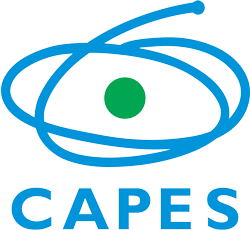Os resumos devem conter entre 200 e 400 palavras excluindo autores e instituições; a formatação de texto (bold, itálico, subscrito, etc..) deverá ser feita com comandos LateX (help disponível no formulário de submissão).
O resumo deve ser obrigatoriamente submetido e apresentado em INGLÊS.
O processo de submissão é composto de 4 (quatro) etapas:
1ª - Escolha da Área, Tipo de Apresentação preferido, Título e informações adicionais sobre o trabalho.
2ª - Autores e Instituições: os autores devem ser agrupados por Instituição e separados por , (vírgula) e inseridos por instituição. O nome do apresentador do trabalho deve ser precedido pelo caractere *(asterisco).
Nomes devem ser inseridos na seguinte ordem:
Primeiro Nome (ou inicial e ponto)
Nomes Intermediários (ou iniciais e pontos)
Último Sobrenome (por extenso)
Exemplo:
First Author, *Segundo Autor, Terzo Autore
ou
F. Author, *S. Autor, T. Autore
Neste caso, o apresentador é "Segundo Autor".
3ª - Digitação do abstract no espaço indicado, fórmulas matemáticas, índices, sobrescrito, subscrito, etc devem ser no formato LateX (help on-line disponível no formulário).
4ª - Nesta etapa o sistema fará a compilação do resumo e exibirá uma tela onde constarão Título, Área Temática, Tipo de Apresentação, Autores, Instituições, o resultado do processamento (OK ou ERRO). Caso o resultado seja OK, basta confirmar a submissão, em caso de ERRO estará disponível um link para o arquivo de log.
obs: os painéis terão espaço de 1x1 metro para colagem ou 1 metro de largura x 2 metros de altura para banner.
Tópicos de Submissão:
1. ATOMIC AND MOLECULAR PHYSICS
1.1 Electronic Structure and Dynamics of Atoms, Molecules and Clusters
1.2 Large Molecular Systems: Clusters, Proteins, Enzymes, Quantum Dots, DNA fragments, and Others
1.3 Exotic Atoms and Molecules
1.4 Atomic and Molecular Collisions
1.5 Photophysics and Spectroscopy of Atomic and Molecular Systems
1.6 Cold Atoms and Bose-Einstein Condensates
1.7 Solvation Effects
2. OPTICS AND PHOTONICS
2.1 Quantum Optics
2.2 Optics and Atomic Physics
2.3 Optical Devices and Applications
2.4 Optical Materials and Nonlinear Optics
2.5 Lasers and Photonics
2.6 Nanophotonics, Nanooptics and Plasmonics
2.7 Biophotonics and applications
2.8 Ultrafast Optics and Time Resolved Dynamics
2.9 Optical Microscopy and Spectroscopy
3. QUANTUM INFORMATION
3.1 Quantum Cryptography, Quantum Communication, and Quantum Measurement
3.2 Quantum Entanglement
3.3 Quantum Computing, Quantum Algorithms, and Quantum Simulation
3.4 Quantum Error Correction and Quantum Control
3.5 Open Quantum Systems and Decoherence
3.6 Physical Implementations of Qubits
3.7 Foundations of Quantum Theory and Quantum Thermodynamics
4. SOFT MATTER
4.1 Polymers: Structure and Dynamics
4.2 Polymers: Electronic and Optical Properties
4.3 Liquid Crystals and Complex Fluids
4.4 Organic Electronics and Photonics
4.5 Biological Fluids, Micellar Structures and Membranes
5. BIOLOGICAL PHYSICS
5.1 Physics of Biological Macromolecules: Dynamics, Function and Interactions
5.2 Physics of Membranes: Biological and Synthetic
5.3 Biological Networks
5.4 Biomechanics
5.5 Physics of Multi-cellular Processes
5.6 Dynamics of Biological Systems
5.7 Biological Materials: Synthesis, Characterization and Applications
5.8 Instrumentation for Biological Physics
5.9 New Methods in Biological Physics
6. MEDICAL PHYSICS
6.1 Radiation Therapy
6.2 Radiodiagnostics
6.3 Imaging Physics
6.4 Radiation Dosimetry
6.5 Nuclear Medicine
6.6 Optical Physics in Medicine
6.7 Instrumentation for Medical Physics
6.8 Acoustical Physics in Medicine
6.9 Biomechanics in Medicine
6.10 Magnetism in Medicine
6.11 - Physics in Nanomedicine
7. INSULATORS AND DIELECTRICS
7.1 Growth, Structure, Properties and Defects
7.2 Oxides
7.3 Minerals and Geological Materials
7.4 Topological Insulators
7.5 Dielectrics
8. METALS AND METALLIC ALLOYS
8.1 Structural, Mechanical and Thermodynamic Properties
8.2 Electronic, Transport and Optical Properties
9. NON-CRYSTALLINE SYSTEMS
9.1 Glasses and Amorphous Materials
9.2 Quasicrystals
9.3 Natural Materials
9.4 Biomaterials
10. MAGNETISM
10.1 Dynamical Magnetization
10.2 Spintronics
10.3 Nano and Molecular Magnetism
10.4 Magnetism in Thin Films and Surfaces
10.5 Theory and Simulation in Magnetism
10.6 Magnetic Semiconductors
10.7 Magnetic Oxides
10.8 Magnetic Devices and Applications
10.9 Magnetocaloric Effect
11. NANOMATERIALS
11.1 Graphene: Monolayer and Multilayer
11.2 2D Materials Beyond Graphene and Van der Waals Heterostructures
11.3 Nanotubes
11.4 Nanowires
11.5 Nanoparticles
11.6 Quantum Dots
12. SEMICONDUCTORS
12.1 Spin-Dependent Phenomena
12.2 Defects and Doping
12.3 Heterostructures
12.4 Material Growth and Surfaces
12.5 Transport Properties
12.6 Optical Properties
12.7 Devices and Applications
12.8 Quantum Hall Effect
13. STRONGLY CORRELATED SYSTEMS
13.1 Metal-Insulator and Other Correlated Phase Transitions
13.2 Heavy Fermions
13.3 Non-Fermi Liquids
13.4 Complex Oxides
13.5 Correlated Electron Magnetism
13.6 Quantum Fluids and Quantum Solids
14. SUPERCONDUCTIVITY
14.1 Materials: Growth, Structure and Characterization
14.2 Theory, Models and Mechanisms of Superconductivity
14.3 Novel Superconductors: Fe-Based, MgB2, Organic, etc.
14.4 Dynamics and Pinning of Vortex Matter
14.5 Superconductivity at the Meso and Nanoscales
14.6 Superconducting Devices and Applications
15. SURFACES, INTERFACES AND THIN FILMS
15.1 Growth, Structure and Morphology
15.2 Surface Reactions and Catalysis
15.3 Electronic and Lattice Properties
15.4 Applied Surface Science
16. THEORY AND SIMULATION
16.1 Electronic Structure Methods
16.2 Classical Monte-Carlo and Molecular Dynamics
16.3 Quantum Many-Body Systems and Methods
16.4 Fluid and Polymer Simulations
17. APPLICATIONS AND DEVICES
17.1 Energy Storage and Conversion
17.2 Photovoltaics
17.3 Thermoelectrics
17.4 Biofuels
17.5 Solid-State Lighting
17.6 Printed Electronics
17.7 Electroacoustics and Piezoelectric Applications and Devices
17.8 Applications of Composite and Hybrid Materials
18. INSTRUMENTATION
18.1 Detectors, Sensors, & Transducers
18.2 Spectroscopic Techniques
18.3 Scattering & Diffraction
18.4 Microscopic and Scanning Probe Techniques
18.5 Signal Processing & Analysis
18.6 Thermal & IR Instrumentation
18.7 Other Instrumentation and Measurement Science
19. NON-EQUILIBRIUM PHENOMENA
19.1 Non-equilibrium phenomena
19.2 Thermalization
20. PHYSICS, GENDER AND MINORITIES
20.1 Physics, Gender and Minorities





